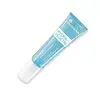What's inside
What's inside
 Key Ingredients
Key Ingredients

 Benefits
Benefits

 Concerns
Concerns

 Ingredients Side-by-side
Ingredients Side-by-side

Water
Skin ConditioningMethylpropanediol
SolventCentaurea Cyanus Flower Water
Skin ConditioningAloe Barbadensis Leaf Juice
Skin ConditioningBetaine
HumectantPropanediol
SolventCarpobrotus Edulis Extract
Hydroxyacetophenone
AntioxidantCarbomer
Emulsion StabilisingEscin
TonicSodium Hydroxide
BufferingMica
Cosmetic ColorantSodium Benzoate
MaskingCellulose Gum
Emulsion StabilisingChenopodium Quinoa Seed Extract
Skin ConditioningTetrasodium EDTA
Silica
AbrasivePotassium Sorbate
PreservativeCitric Acid
BufferingCI 77891
Cosmetic ColorantWater, Methylpropanediol, Centaurea Cyanus Flower Water, Aloe Barbadensis Leaf Juice, Betaine, Propanediol, Carpobrotus Edulis Extract, Hydroxyacetophenone, Carbomer, Escin, Sodium Hydroxide, Mica, Sodium Benzoate, Cellulose Gum, Chenopodium Quinoa Seed Extract, Tetrasodium EDTA, Silica, Potassium Sorbate, Citric Acid, CI 77891
Water
Skin ConditioningButylene Glycol
HumectantSorbitol
HumectantBetaine
HumectantPanthenol
Skin ConditioningGlycerin
HumectantUrea
BufferingCaffeine
Skin ConditioningEscin
TonicSerine
MaskingSodium Hyaluronate
HumectantRuscus Aculeatus Root Extract
AstringentBiosaccharide Gum-1
HumectantCentella Asiatica Leaf Extract
Skin ConditioningAlgin
MaskingPullulan
Calendula Officinalis Flower Extract
MaskingPhenoxyethanol
PreservativeGlyceryl Polyacrylate
Trehalose
HumectantCarbomer
Emulsion StabilisingEthylhexylglycerin
Skin ConditioningPentylene Glycol
Skin ConditioningAmmonium Glycyrrhizate
MaskingSodium Hydroxide
BufferingCaprylyl Glycol
EmollientDisodium Phosphate
BufferingHydrolyzed Yeast Protein
Skin ConditioningSodium Citrate
BufferingPantolactone
HumectantPotassium Phosphate
BufferingCitric Acid
BufferingWater, Butylene Glycol, Sorbitol, Betaine, Panthenol, Glycerin, Urea, Caffeine, Escin, Serine, Sodium Hyaluronate, Ruscus Aculeatus Root Extract, Biosaccharide Gum-1, Centella Asiatica Leaf Extract, Algin, Pullulan, Calendula Officinalis Flower Extract, Phenoxyethanol, Glyceryl Polyacrylate, Trehalose, Carbomer, Ethylhexylglycerin, Pentylene Glycol, Ammonium Glycyrrhizate, Sodium Hydroxide, Caprylyl Glycol, Disodium Phosphate, Hydrolyzed Yeast Protein, Sodium Citrate, Pantolactone, Potassium Phosphate, Citric Acid
Ingredients Explained
These ingredients are found in both products.
Ingredients higher up in an ingredient list are typically present in a larger amount.
Betaine is a common humectant (a substance that promotes retention of moisture). It's known to be gentle on the skin and can help balance hydration.
This ingredient is best for improving hydration and soothing irritated skin. Studies also show it helps even out skin tone.
Fun fact: Betaine is naturally created in the skin and body. The kind found within cosmetic products can be either plant-derived or synthetic.
Another name for betaine is trimethylglycine.
Learn more about BetaineCarbomer is a polymer of acrylic acid. Its main role is to create a gel consistency.
A high amount of carbomer can cause pilling or balling up of products. Don't worry, most products contain 1% or less of carbomer.
Citric Acid is an alpha hydroxy acid (AHA) naturally found in citrus fruits like oranges, lemons, and limes.
Like other AHAs, citric acid can exfoliate skin by breaking down the bonds that hold dead skin cells together. This helps reveal smoother and brighter skin underneath.
However, this exfoliating effect only happens at high concentrations (20%) which can be hard to find in cosmetic products.
Due to this, citric acid is usually included in small amounts as a pH adjuster. This helps keep products slightly more acidic and compatible with skin's natural pH.
In skincare formulas, citric acid can:
While it can provide some skin benefits, research shows lactic acid and glycolic acid are generally more effective and less irritating exfoliants.
Most citric acid used in skincare today is made by fermenting sugars (usually from molasses). This synthetic version is identical to the natural citrus form but easier to stabilize and use in formulations.
Read more about some other popular AHA's here:
Learn more about Citric AcidWe don't have a description for Escin yet.
Sodium Hydroxide is also known as lye or caustic soda. It is used to adjust the pH of products; many ingredients require a specific pH to be effective.
In small amounts, sodium hydroxide is considered safe to use. However, large amounts may cause chemical burns due to its high alkaline.
Your skin has a natural pH and acid mantle. This acid mantle helps prevent harmful bacteria from breaking through. The acid mantle also helps keep your skin hydrated.
"Alkaline" refers to a high pH level. A low pH level would be considered acidic.
Learn more about Sodium HydroxideWater. It's the most common cosmetic ingredient of all. You'll usually see it at the top of ingredient lists, meaning that it makes up the largest part of the product.
So why is it so popular? Water most often acts as a solvent - this means that it helps dissolve other ingredients into the formulation.
You'll also recognize water as that liquid we all need to stay alive. If you see this, drink a glass of water. Stay hydrated!
Learn more about Water